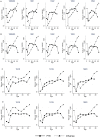Influenza Pandemics and Tuberculosis Mortality in 1889 and 1918: Analysis of Historical Data from Switzerland
- PMID: 27706149
- PMCID: PMC5051959
- DOI: 10.1371/journal.pone.0162575
Influenza Pandemics and Tuberculosis Mortality in 1889 and 1918: Analysis of Historical Data from Switzerland
Abstract
Background: Tuberculosis (TB) mortality declined in the northern hemisphere over the last 200 years, but peaked during the Russian (1889) and the Spanish (1918) influenza pandemics. We studied the impact of these two pandemics on TB mortality.
Methods: We retrieved historic data from mortality registers for the city of Bern and countrywide for Switzerland. We used Poisson regression models to quantify the excess pulmonary TB (PTB) mortality attributable to influenza.
Results: Yearly PTB mortality rates increased during both influenza pandemics. Monthly influenza and PTB mortality rates peaked during winter and early spring. In Bern, for an increase of 100 influenza deaths (per 100,000 population) monthly PTB mortality rates increased by a factor of 1.5 (95%Cl 1.4-1.6, p<0.001) during the Russian, and 3.6 (95%Cl 0.7-18.0, p = 0.13) during the Spanish pandemic. Nationally, the factor was 2.0 (95%Cl 1.8-2.2, p<0.001) and 1.5 (95%Cl 1.1-1.9, p = 0.004), respectively. We did not observe any excess cancer or extrapulmonary TB mortality (as a negative control) during the influenza pandemics.
Conclusions: We demonstrate excess PTB mortality during historic influenza pandemics in Switzerland, which supports a role for influenza vaccination in PTB patients in high TB incidence countries.
Conflict of interest statement
The authors have declared that no competing interests exist.
Figures



Similar articles
-
Excess Mortality Associated with Influenza among Tuberculosis Deaths in South Africa, 1999-2009.PLoS One. 2015 Jun 15;10(6):e0129173. doi: 10.1371/journal.pone.0129173. eCollection 2015. PLoS One. 2015. PMID: 26076197 Free PMC article.
-
Age-specific excess mortality patterns and transmissibility during the 1889-1890 influenza pandemic in Madrid, Spain.Ann Epidemiol. 2018 May;28(5):267-272. doi: 10.1016/j.annepidem.2017.12.009. Epub 2017 Dec 27. Ann Epidemiol. 2018. PMID: 29336941
-
[Transmissibility and severity of the pandemic influenza A (H1N1) 2009 virus in Spain].Gac Sanit. 2011 Jul-Aug;25(4):296-302. doi: 10.1016/j.gaceta.2011.02.008. Epub 2011 May 2. Gac Sanit. 2011. PMID: 21543138 Spanish.
-
[Influenza pandemic deaths in Germany from 1918 to 2009. Estimates based on literature and own calculations].Bundesgesundheitsblatt Gesundheitsforschung Gesundheitsschutz. 2016 Apr;59(4):523-36. doi: 10.1007/s00103-016-2324-9. Bundesgesundheitsblatt Gesundheitsforschung Gesundheitsschutz. 2016. PMID: 26984565 Review. German.
-
Long time due: reducing tuberculosis mortality in the 21st century.Arch Med Res. 2005 Nov-Dec;36(6):617-21. doi: 10.1016/j.arcmed.2005.06.002. Arch Med Res. 2005. PMID: 16216642 Review.
Cited by
-
Tuberculosis as a Risk Factor for 1918 Influenza Pandemic Outcomes.Trop Med Infect Dis. 2019 Apr 29;4(2):74. doi: 10.3390/tropicalmed4020074. Trop Med Infect Dis. 2019. PMID: 31035651 Free PMC article.
-
The Impact of Influenza and Tuberculosis Interaction on Mortality Among Individuals Aged ≥15 Years Hospitalized With Severe Respiratory Illness in South Africa, 2010-2016.Open Forum Infect Dis. 2019 Mar 19;6(3):ofz020. doi: 10.1093/ofid/ofz020. eCollection 2019 Mar. Open Forum Infect Dis. 2019. PMID: 30906797 Free PMC article.
-
The Wonder Years: What Can Primary School Children Teach Us About Immunity to Mycobacterium tuberculosis?Front Immunol. 2018 Dec 13;9:2946. doi: 10.3389/fimmu.2018.02946. eCollection 2018. Front Immunol. 2018. PMID: 30619306 Free PMC article. Review.
-
Tuberculosis, COVID-19, and the End Tuberculosis strategy in India.Lung India. 2020 Nov-Dec;37(6):467-472. doi: 10.4103/lungindia.lungindia_544_20. Lung India. 2020. PMID: 33154206 Free PMC article. No abstract available.
-
Epidemic and pandemic viral infections: impact on tuberculosis and the lung: A consensus by the World Association for Infectious Diseases and Immunological Disorders (WAidid), Global Tuberculosis Network (GTN), and members of the European Society of Clinical Microbiology and Infectious Diseases Study Group for Mycobacterial Infections (ESGMYC).Eur Respir J. 2020 Oct 1;56(4):2001727. doi: 10.1183/13993003.01727-2020. Print 2020 Oct. Eur Respir J. 2020. PMID: 32586885 Free PMC article. Review.
References
-
- Grigg ERN. The arcana of tuberculosis with a brief epidemiologic history of the disease in the U.S.A. American review of tuberculosis. 1958;78(2):151–72 contd. Epub 1958/08/01. . - PubMed
-
- World Health Organization. Global tuberculosis report. World Health Organization Document WHO/HTM/TB/2015.22. 2015:1–204.
-
- Potter CW. A history of influenza. J Appl Microbiol. 2001;91(4):572–9. Epub 2001/09/29. . - PubMed
Publication types
MeSH terms
LinkOut - more resources
Full Text Sources
Other Literature Sources
Medical

